Abstract
OBJECTIVE--To investigate whether plaque rupture and thrombosis have a role in silent ischaemia as well as in unstable angina. DESIGN--Prospective analysis of the results of haemostatic diagnostic tests at the moment of developing silent ischaemia at rest. SETTING--Coronary care unit. PATIENTS--22 patients with acute myocardial infarction, 12 patients with symptomatic angina (unstable angina), and 10 normal volunteers (control group). INTERVENTIONS--Continuous cardiac monitoring detected 15 asymptomatic episodes (silent ischaemia) in 6 patients with unstable angina. Blood samples were obtained at admission and when an asymptomatic alteration was detected and 10 minutes later. MAIN OUTCOME MEASURES--Comparisons of concentrations of tissue plasminogen activator, urokinase type plasminogen activator, tissue plasminogen activator inhibitor-1, cross-linked fibrin degradation products, von Willebrand factor, and thrombin-antithrombin III complexes in patients and controls at admission; same comparisons in patients with silent ischaemia at the start of an episode and 10 minutes later. RESULTS--Tissue plasminogen activator concentrations were raised at admission in patients with acute myocardial infarction (mean (SD) 14.2 (6) ng/ml) and in patients with unstable angina (10.1 (2.5) ng/ml) in comparison with controls (5.1 (2.7) ng/ml, p < 0.01 and < 0.05 respectively). There was no differences between the two groups of patients, however. Similar results were observed at the start of a silent ischaemic episode (9.8 (1.9) ng/ml) and 10 minutes later (10.5 (2.9) ng/ml) compared with controls (p < 0.05). Tissue plasminogen activator inhibitor-1 concentrations were raised in patients with acute myocardial infarction (45.1 (15) ng/ml) compared with volunteers (20.6 (16) ng/ml, p < 0.01). In patients with silent ischaemia tissue plasminogen activator inhibitor-1 concentrations were slightly but not significantly increased. Concentrations of cross-linked fibrin degradation products (D dimer) increased during unstable angina (2150 (350) ng/ml) and silent ischaemia (2270 (450) ng/ml) compared with the concentrations in volunteers (340 (80) ng/ml) and patients with acute myocardial infarction (310 (120) ng/ml; p < 0.01). CONCLUSIONS--The results suggest that thrombosis mediates the pathophysiological mechanisms of silent ischaemia and unstable angina.
Full text
PDF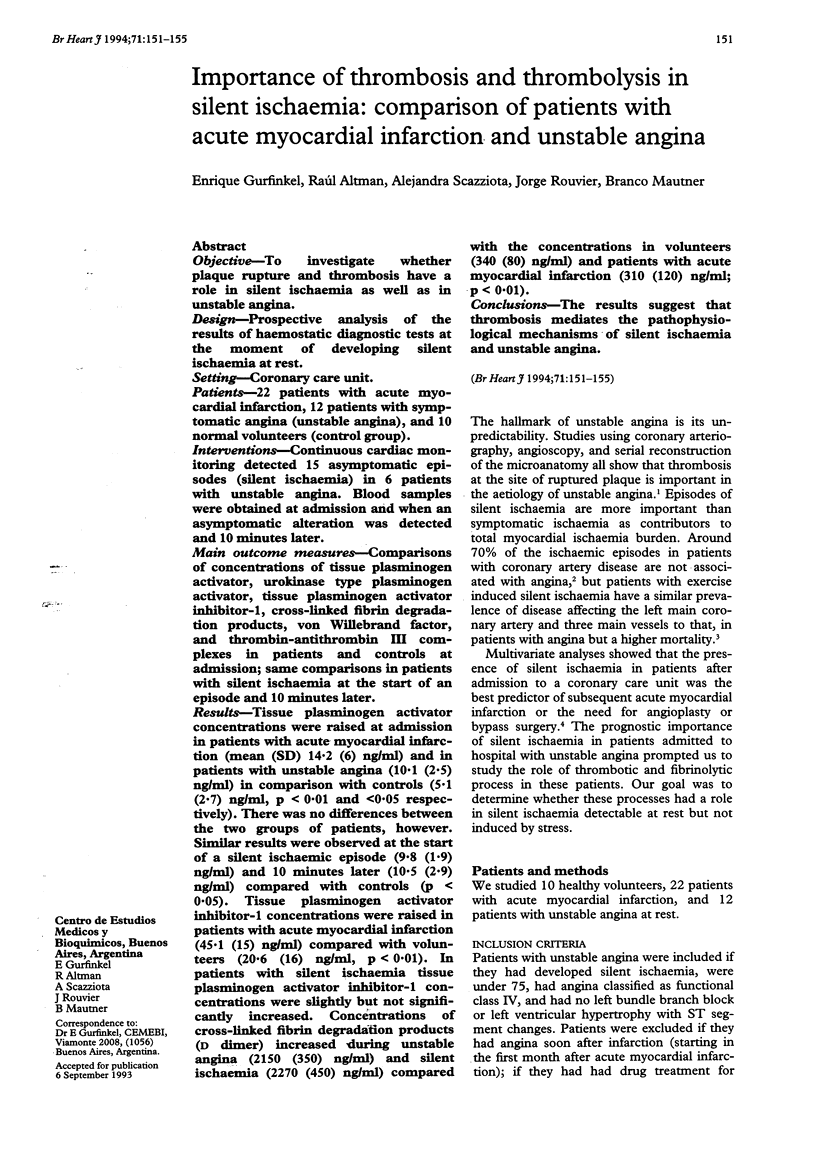
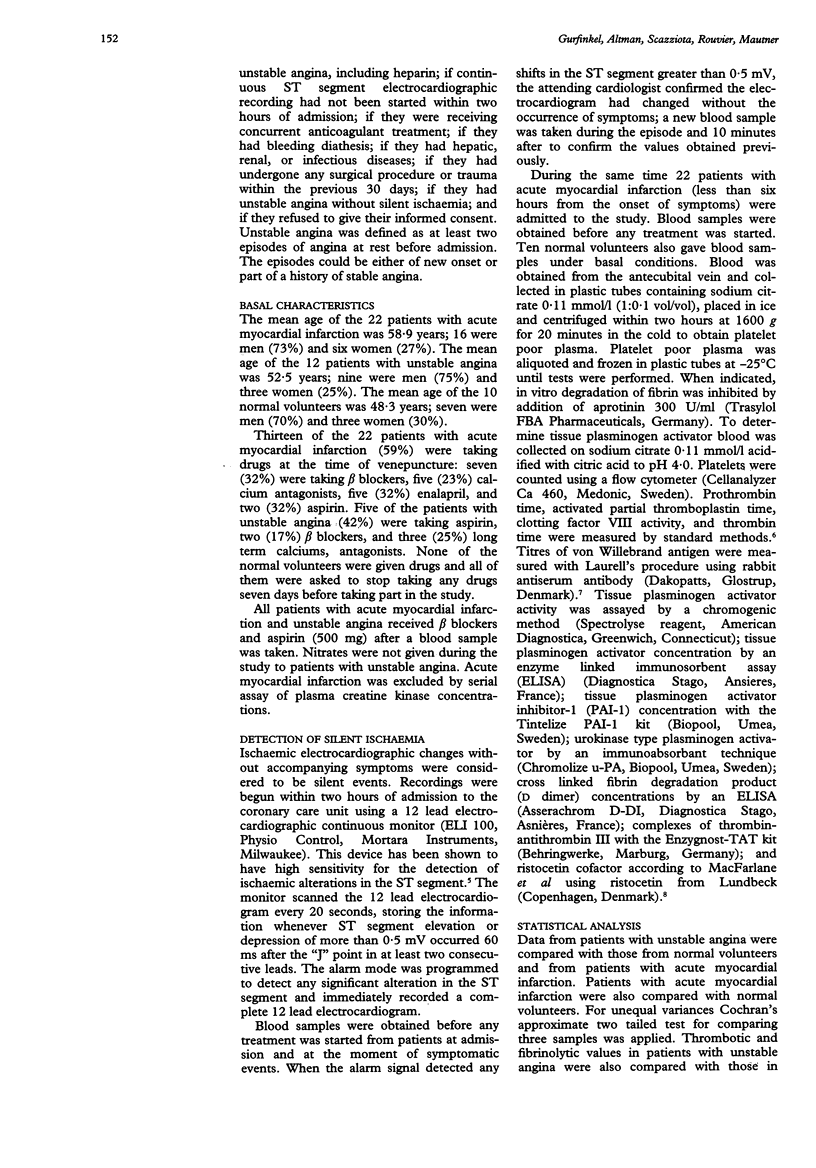
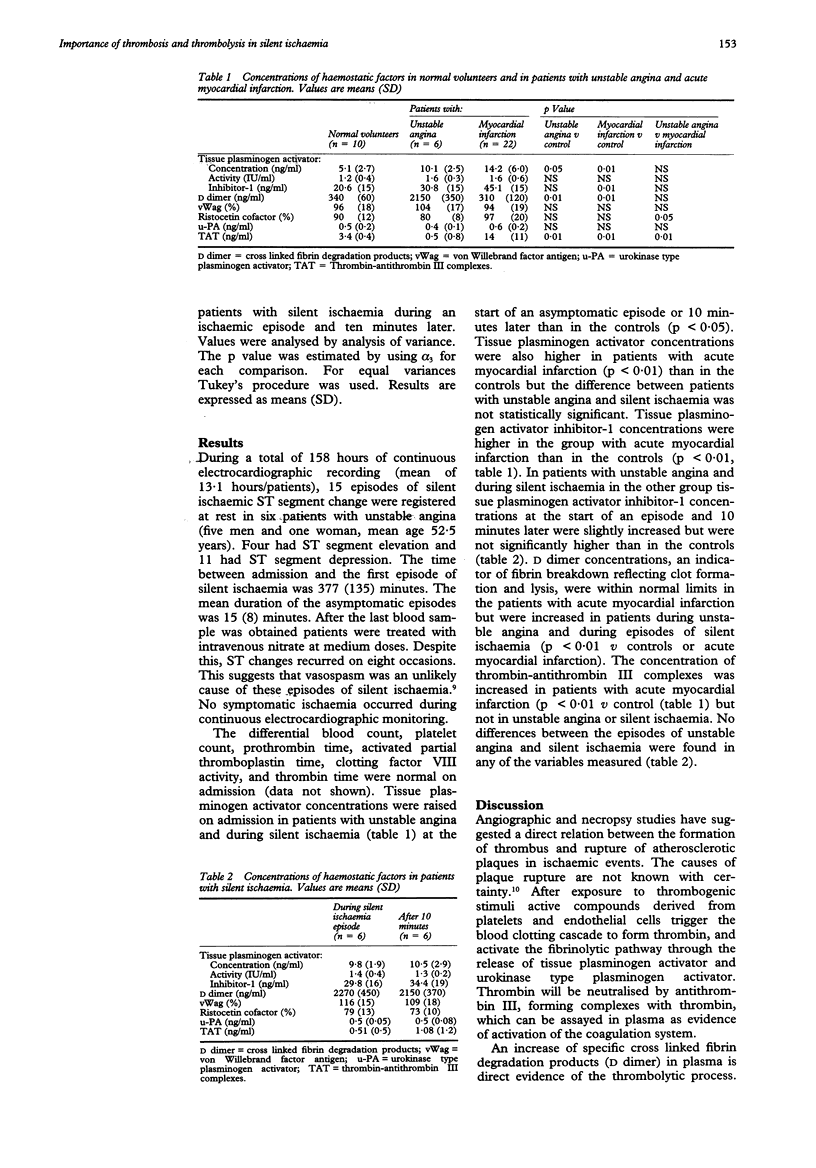
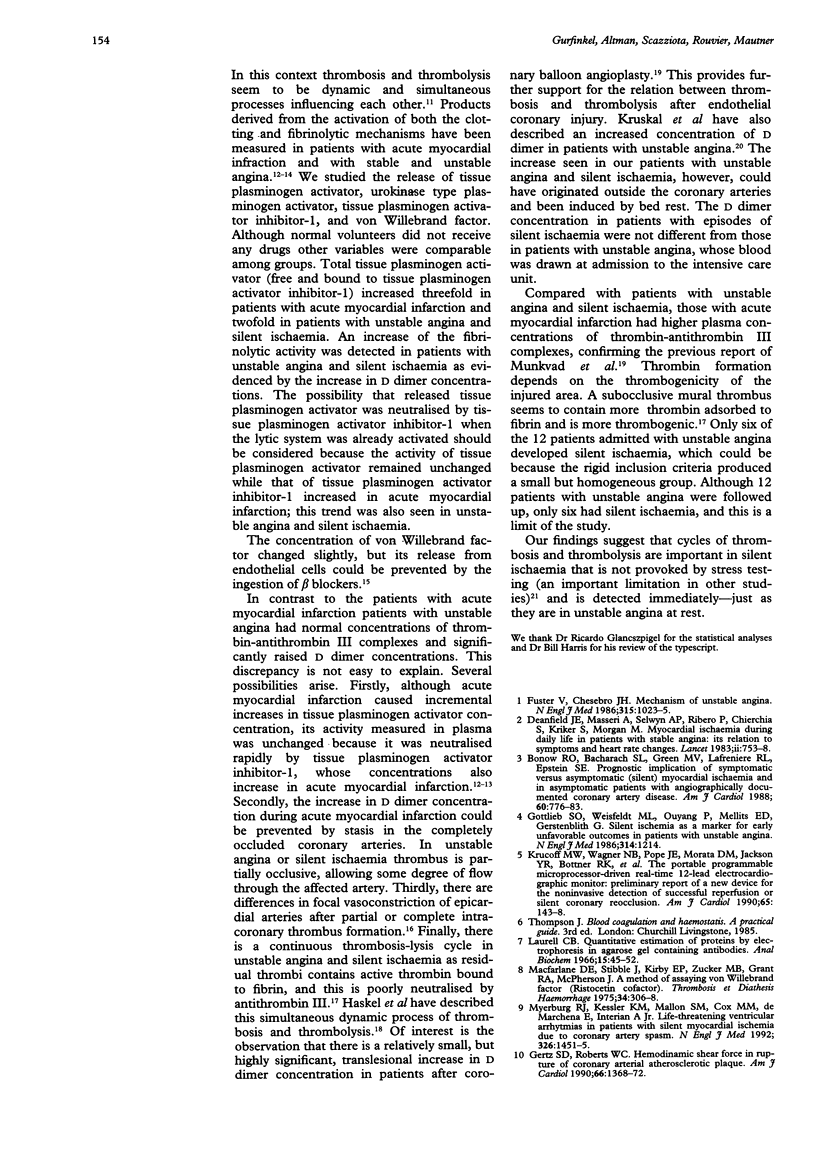
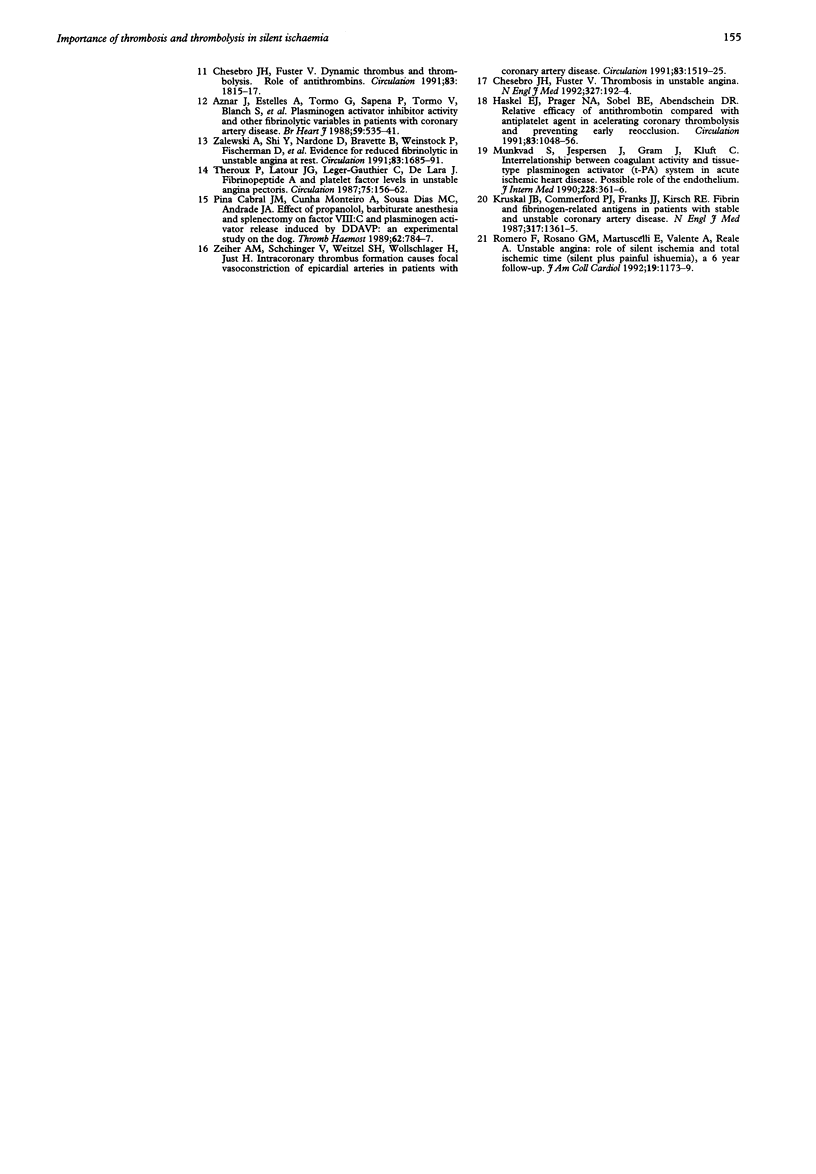
Selected References
These references are in PubMed. This may not be the complete list of references from this article.
- Chesebro J. H., Fuster V. Dynamic thrombosis and thrombolysis. Role of antithrombins. Circulation. 1991 May;83(5):1815–1817. doi: 10.1161/01.cir.83.5.1815. [DOI] [PubMed] [Google Scholar]
- Chesebro J. H., Fuster V. Thrombosis in unstable angina. N Engl J Med. 1992 Jul 16;327(3):192–194. doi: 10.1056/NEJM199207163270310. [DOI] [PubMed] [Google Scholar]
- Deanfield J. E., Maseri A., Selwyn A. P., Ribeiro P., Chierchia S., Krikler S., Morgan M. Myocardial ischaemia during daily life in patients with stable angina: its relation to symptoms and heart rate changes. Lancet. 1983 Oct 1;2(8353):753–758. doi: 10.1016/s0140-6736(83)92295-x. [DOI] [PubMed] [Google Scholar]
- Fuster V., Chesebro J. H. Mechanisms of unstable angina. N Engl J Med. 1986 Oct 16;315(16):1023–1025. doi: 10.1056/NEJM198610163151608. [DOI] [PubMed] [Google Scholar]
- Gertz S. D., Roberts W. C. Hemodynamic shear force in rupture of coronary arterial atherosclerotic plaques. Am J Cardiol. 1990 Dec 1;66(19):1368–1372. doi: 10.1016/0002-9149(90)91170-b. [DOI] [PubMed] [Google Scholar]
- Gottlieb S. O., Weisfeldt M. L., Ouyang P., Mellits E. D., Gerstenblith G. Silent ischemia as a marker for early unfavorable outcomes in patients with unstable angina. N Engl J Med. 1986 May 8;314(19):1214–1219. doi: 10.1056/NEJM198605083141903. [DOI] [PubMed] [Google Scholar]
- Haskel E. J., Prager N. A., Sobel B. E., Abendschein D. R. Relative efficacy of antithrombin compared with antiplatelet agents in accelerating coronary thrombolysis and preventing early reocclusion. Circulation. 1991 Mar;83(3):1048–1056. doi: 10.1161/01.cir.83.3.1048. [DOI] [PubMed] [Google Scholar]
- Krucoff M. W., Wagner N. B., Pope J. E., Mortara D. M., Jackson Y. R., Bottner R. K., Wagner G. S., Kent K. M. The portable programmable microprocessor-driven real-time 12-lead electrocardiographic monitor: a preliminary report of a new device for the noninvasive detection of successful reperfusion or silent coronary reocclusion. Am J Cardiol. 1990 Jan 15;65(3):143–148. doi: 10.1016/0002-9149(90)90075-c. [DOI] [PubMed] [Google Scholar]
- Kruskal J. B., Commerford P. J., Franks J. J., Kirsch R. E. Fibrin and fibrinogen-related antigens in patients with stable and unstable coronary artery disease. N Engl J Med. 1987 Nov 26;317(22):1361–1365. doi: 10.1056/NEJM198711263172201. [DOI] [PubMed] [Google Scholar]
- Laurell C. B. Quantitative estimation of proteins by electrophoresis in agarose gel containing antibodies. Anal Biochem. 1966 Apr;15(1):45–52. doi: 10.1016/0003-2697(66)90246-6. [DOI] [PubMed] [Google Scholar]
- Macfarlane D. E., Stibbe J., Kirby E. P., Zucker M. B., Grant R. A., McPherson J. Letter: A method for assaying von Willebrand factor (ristocetin cofactor). Thromb Diath Haemorrh. 1975 Sep 30;34(1):306–308. [PubMed] [Google Scholar]
- Munkvad S., Jespersen J., Gram J., Kluft C. Interrelationship between coagulant activity and tissue-type plasminogen activator (t-PA) system in acute ischaemic heart disease. Possible role of the endothelium. J Intern Med. 1990 Oct;228(4):361–366. doi: 10.1111/j.1365-2796.1990.tb00246.x. [DOI] [PubMed] [Google Scholar]
- Myerburg R. J., Kessler K. M., Mallon S. M., Cox M. M., deMarchena E., Interian A., Jr, Castellanos A. Life-threatening ventricular arrhythmias in patients with silent myocardial ischemia due to coronary-artery spasm. N Engl J Med. 1992 May 28;326(22):1451–1455. doi: 10.1056/NEJM199205283262202. [DOI] [PubMed] [Google Scholar]
- Pina-Cabral J. M., Cunha-Monteiro A., Sousa-Dias M. C., Andrade J. A. Effect of propranolol, barbiturate anesthesia and splenectomy on factor VIII:C and plasminogen activator release induced by DDAVP. An experimental study on the dog. Thromb Haemost. 1989 Sep 29;62(2):784–787. [PubMed] [Google Scholar]
- Romeo F., Rosano G. M., Martuscelli E., Valente A., Reale A. Unstable angina: role of silent ischemia and total ischemic time (silent plus painful ischemia), a 6-year follow-up. J Am Coll Cardiol. 1992 May;19(6):1173–1179. doi: 10.1016/0735-1097(92)90320-m. [DOI] [PubMed] [Google Scholar]
- Théroux P., Latour J. G., Léger-Gauthier C., De Lara J. Fibrinopeptide A and platelet factor levels in unstable angina pectoris. Circulation. 1987 Jan;75(1):156–162. doi: 10.1161/01.cir.75.1.156. [DOI] [PubMed] [Google Scholar]
- Zalewski A., Shi Y., Nardone D., Bravette B., Weinstock P., Fischman D., Wilson P., Goldberg S., Levin D. C., Bjornsson T. D. Evidence for reduced fibrinolytic activity in unstable angina at rest. Clinical, biochemical, and angiographic correlates. Circulation. 1991 May;83(5):1685–1691. doi: 10.1161/01.cir.83.5.1685. [DOI] [PubMed] [Google Scholar]
- Zeiher A. M., Schächinger V., Weitzel S. H., Wollschläger H., Just H. Intracoronary thrombus formation causes focal vasoconstriction of epicardial arteries in patients with coronary artery disease. Circulation. 1991 May;83(5):1519–1525. doi: 10.1161/01.cir.83.5.1519. [DOI] [PubMed] [Google Scholar]


